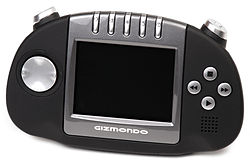 | |
 | |
| Manufacturer | Tiger Telematics |
|---|---|
| Type | Handheld game console |
| Generation | Seventh |
| Release date | 19 March 2005 |
| Discontinued | 6 February 2006 |
| Units sold | est. < 25,000[1] |
| Media | SD, MMC |
| Operating system | Windows CE |
| CPU | ARM9 S3C2440 @ 400 MHz |
| Display | 2.8 inches (7.1 cm) TFT LCD |
| Connectivity | Bluetooth, GPRS, GPS |
| Best-selling game | Sticky Balls |
The Gizmondo is a handheld gaming console developed by Gizmondo Europe. Its development was led by Swedish entrepreneur Carl Freer,[2] who served as chairman of its parent company, Tiger Telematics. The device was originally launched on 19 March 2005 in Britain;[3] although releases in other European territories were planned for 19 May,[4] this never occurred, and it instead only received a limited release in Sweden. It also had a limited release in the United States in October 2005. The Gizmondo was produced and marketed until 2006 when Gizmondo Europe was liquidated.[5]
Powered by an ARM9 processor, the Gizmondo had the usual features seen in handheld consoles of the time (Nintendo DS, PlayStation Portable, Nokia N-Gage) but notably also included a digital camera and a built-in GPS chip. Additionally, it also had mobile cellular connectivity, giving the ability to send SMS text messages and MMS picture messages (although no telephone capabilities), as well as browse WAP webpages and email using its GPRS connection.[6] Software-wise, the Gizmondo runs on Windows CE.[6] First-party game studios were located in Sweden and England to develop video games for the system.
In an attempt to promote the product's launch, Gizmondo Europe extravagantly spent millions on promotions such as a celebrity party at London's Park Lane Hotel, and taking part at the 24 Hours of Le Mans, despite never making a profit. Despite a degree of market expectation[7] it ended up as a major sales failure;[8] this was further worsened by a delay in its American release and the announcement of a widescreen version shortly before debuting there.[9][10] The company was further overshadowed by Swedish press reports of criminal pasts of its executives, including Gizmondo Europe's director Stefan Eriksson's past as an organised crime figure.[11]
- ^ Snow, Blake (2007-07-30). "The 10 Worst-Selling Handhelds of All Time". GamePro.com. Archived from the original on 2007-10-12. Retrieved 2008-01-17.
- ^ "Gizmondo Launch Brings London's West End to a Standstill - Press Release". Archived from the original on 2016-08-20. Retrieved 22 January 2017.
- ^ "Gizmondo gadget hits the shelves". BBC News Online. 2005-03-19. Archived from the original on 2008-02-15. Retrieved 2007-11-23.
- ^ Contributor, GamesIndustry biz (2005-05-20). "Tiger Telematics' Gizmondo™ Confirms New Tech and E3 Game Line-up". GamesIndustry.biz. Retrieved 2024-10-01.
{{cite web}}:|last=has generic name (help) - ^ "Gizmondo Europe goes into liquidation". Pocket-Lint. 2006-02-07. Retrieved 2013-01-14.[permanent dead link]
- ^ a b Contributor, Ellie Gibson (2005-03-21). "Gizmondo launches in the UK; Vodafone signs up to provide SIM cards". GamesIndustry.biz. Retrieved 2024-10-01.
{{cite web}}:|last=has generic name (help) - ^ "CEBIT 2005: Gizmondo out this week - Hardware - News". HEXUS.net. 2005-03-16. Archived from the original on 2012-08-01. Retrieved 2013-01-14.
- ^ "Gizmondo price drop - Hardware - News". HEXUS.net. 2005-04-12. Archived from the original on 2013-11-04. Retrieved 2013-01-14.
- ^ "Tiger Doesn't Want You to Buy the Gizmondo! - Defunct Games". Archived from the original on 2017-02-02. Retrieved 22 January 2017.
- ^ Smith, Tony (5 August 2005). "Gizmondo US launch 'put back to October'". The Register. Archived from the original on 2017-02-02. Retrieved 22 January 2017.
- ^ Sullivan, Randall. "Gizmondo's Spectacular Crack-up". Wired. Archived from the original on 2016-12-27. Retrieved 22 January 2017.